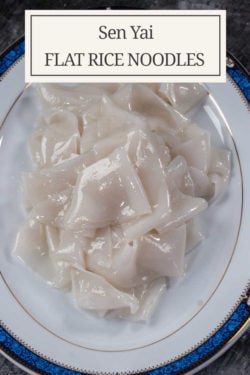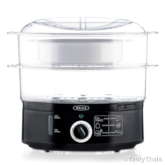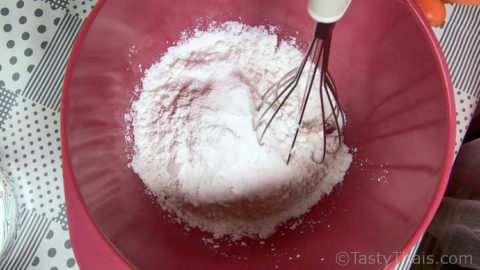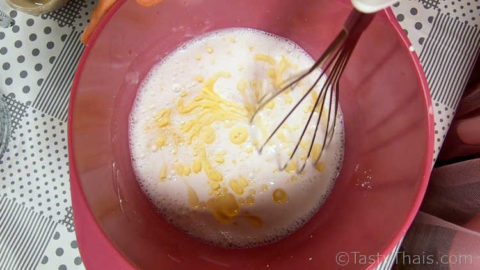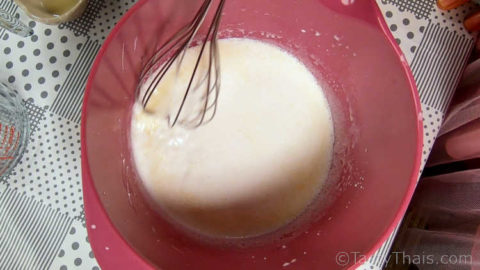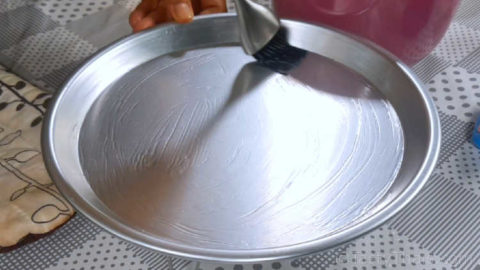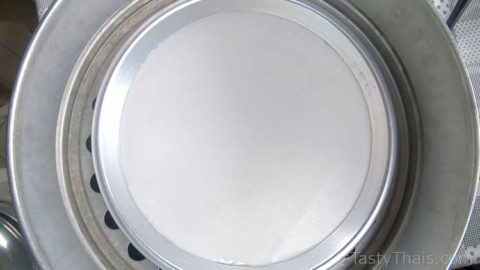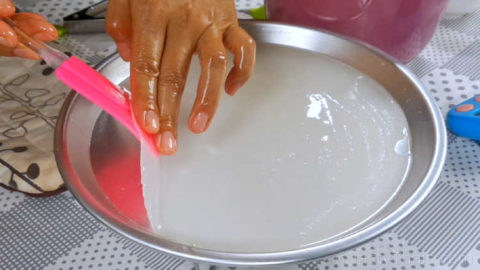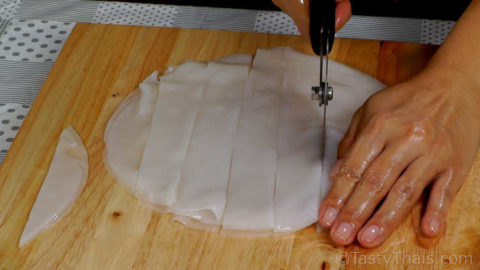Fresh wide rice noodles are readily available in Thailand but are harder to find in the West because they do not keep well. You might find them in a good Asian store if you have one near but making homemade rice noodles for your Thai stir fry dishes is quick and easy, not to mention cheap.
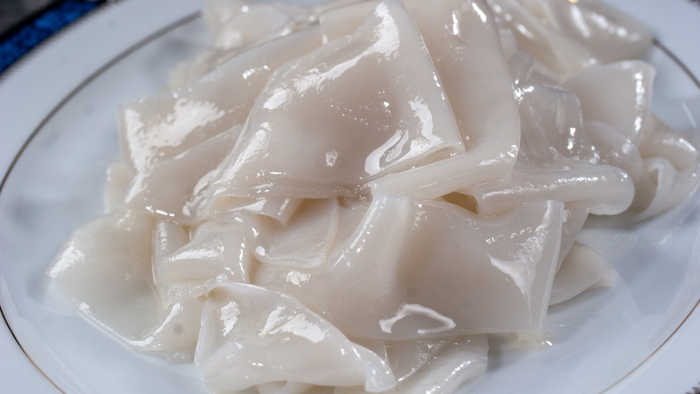
Here are some jump links if you want to rush straight to the recipe – you’ll miss a lot of tips contained in the step by step guide though.
Homemade rice noodles can be used to create wide flat rice noodles which we call ‘Sen Yai’. Some of our favorite recipes with rice noodles are the stir fry dishes such as Pad Kee Mao or drunken noodles, Pad See Ew and in some noodle soups that use wide Thai rice noodles such as the pink noodle soup called “เย็นตาโฟ – yen ta fo” and the famous noodles in gravy, Rad Na.
Video Cooking Show – Making Wide Rice Noodles
This recipe is also suitable to make rice noodles for pho – the classic Vietnamese dish and Pad Thai – just cut the noodle sheets thinner.
Ingredients You’ll Need
You only need a few ingredients for rice noodles:
- Rice Flour
- Tapioca Starch or Tapioca Flour
- Warm Water
- Salt
- Premium Oil such as Olive Oil
- Oil to Prevent Sticking – vegetable cooking oil is cheapest.
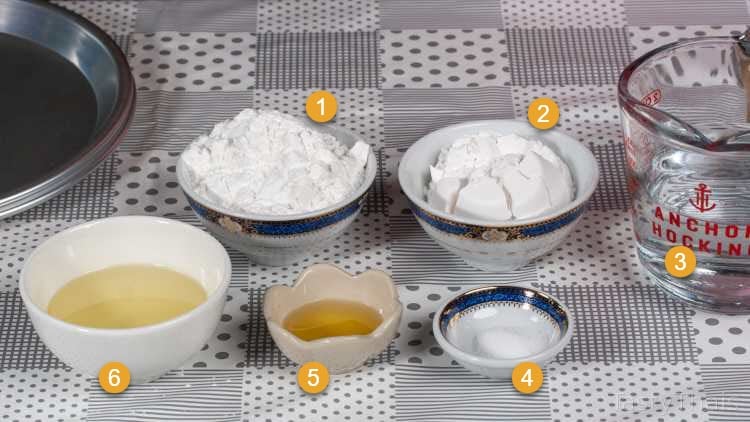
Rice Noodles Calories & Carbs
What are rice noodles made of?
Rice noodles are made with rice flour or a mixture of rice and tapioca flour as with this flat rice noodles recipe.
Flat rice noodles are quite high is both calories and carbs. The carbohydrates come from the flour and the protective oil that helps stop them from sticking add to the calorie count. The calories in rice noodles come to about 110 kCal per serving (100g) – even without counting the oil used to stop them attaching to one another.
You will get a misleading view if you don’t compensate for the fact that you need very little extra oil to cook them (because the oil is already on them) which is easy to overlook when making comparisons with dry noodles for example.
So when calculating rice noodles nutrition the coating oil is not included and in any case, will be of little use since the amounts will vary very considerably.
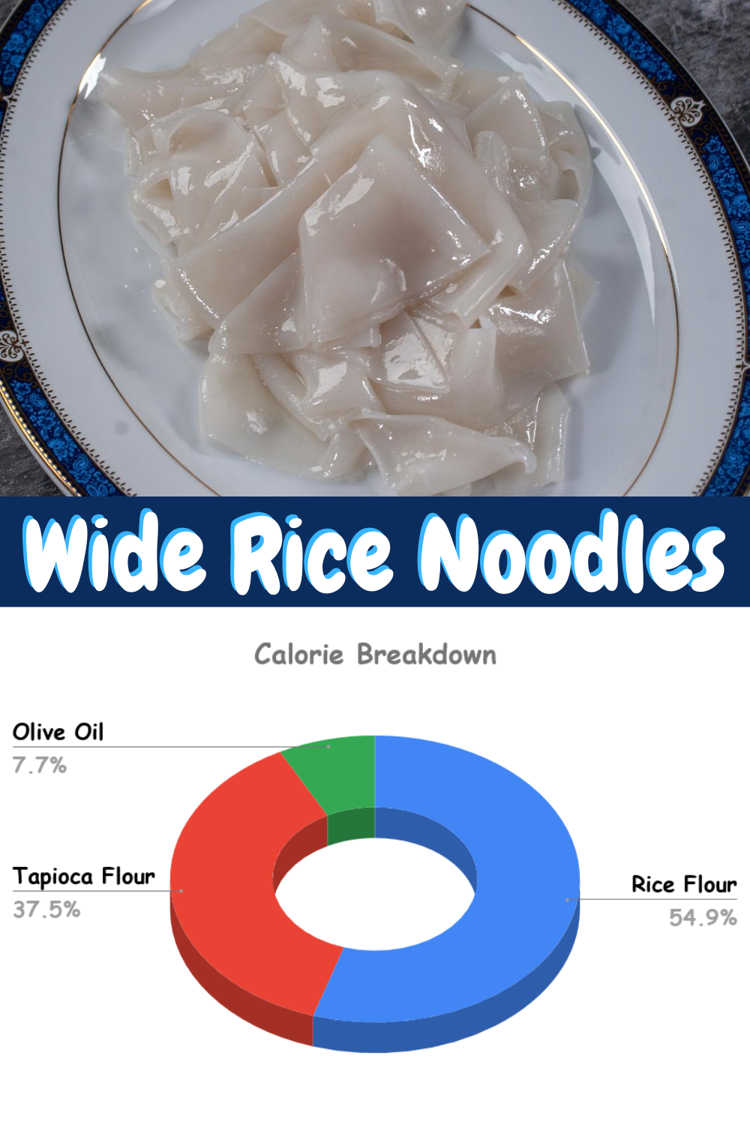
Rice Noodles vs Egg Noodles – What is the Difference?
Egg noodles are mostly made using wheat flour with egg. Wheat flour has slightly fewer calories compared to rice & tapioca flour used in rice noodles.
But the egg more than compensates with egg noodles – at around 140 kCal per serving (100g) have nearly 30% more calories than rice noodles (but then they have more protein too). The carbohydrate content is close enough identical.
For all practical reasons the calories in either work out much the same. More important is that rice noodles are usually gluten-free (but check the packaging to ensure no trace gluten if it is important to your diet) whereas most egg noodles are not – but egg noodles do have a bit more color.
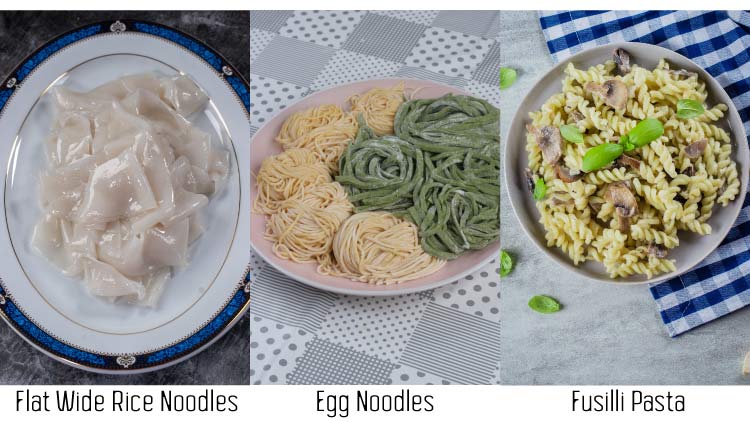
Rice Noodles vs Pasta – Differences
If you are comparing pasta with rice noodles then the calorie difference is significant co far as considering simply the single ingredient. Cooked pasta has around 130 kCal per serving (100g) or nearly 25% more calories than cooked rice noodles.
However pasta is rather drier than noodles generally and so harder to eat and so paired with ingredients that add more calories than recipes with rice noodles – Thai recipes are usually stir-fried or added to soups.
As for carbohydrates, the difference between noodles and pasta is negligible.
So between Fresh Rice Noodles, Egg Noodles, and Pasta – the rice noodles are the least calorific. Terrific!
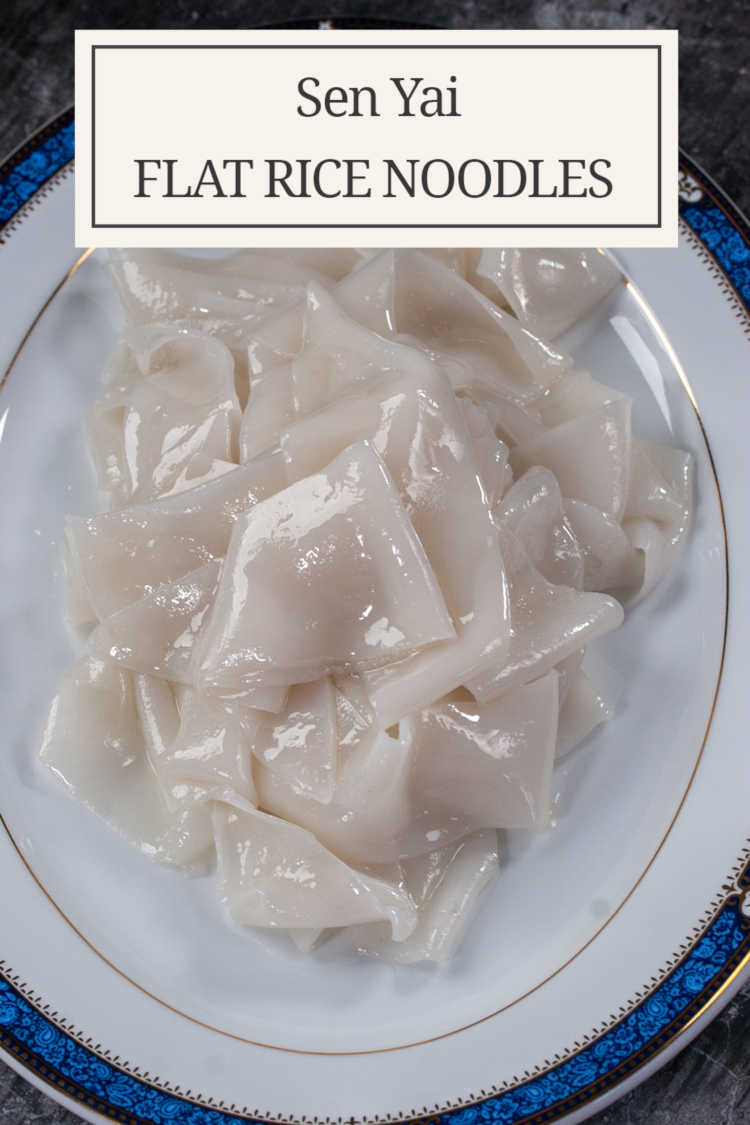
How to Make Rice Noodles – Step by Step
Making rice noodles is easy as you will see in the recipe below. Here we cover each step and why we do what we do. Knowing why is a great way to improve your cooking skills and help remember the steps.
It is an easy process but there are quite a few little bits of knowledge to help and so you will hopefully benefit greatly from checking out the steps below for tips and tricks.
Step 1 – Making the Rice Noodle Batter
Most batters are a mixture of some form of flour, water, and a little fat and Thai rice noodles are no exception.
The flour used makes a difference to consistency and to a lesser extent taste. Tapioca flour is used in addition to rice flour because the tapioca starch adds a little chewiness to the mix. If you just use rice flour then the noodle sheets will break too easily unless you increase thickness.
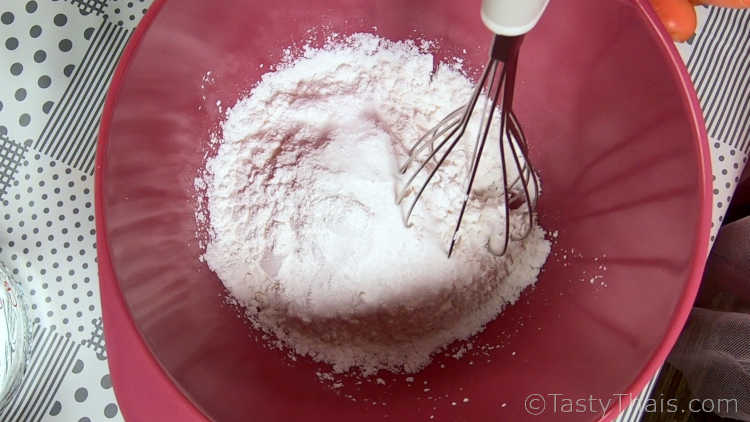
The best noodles for stir fry have a gently chewy texture and are quite thin. Cheaper noodles are thicker and markedly more chewy – tough even – because they are easier to process that way.
We want quality!
To achieve this we add tapioca flour, sometimes called tapioca starch, to the rice flour and take care of your steaming time, allowing us to make nice thin, wide noodles that have just the right chewiness.
To make the batter we use tepid water which helps the flour absorb it more easily and a little oil which helps make the noodles a little easier to work with during the cooking process – they still stick but just a bit less.
So add the rice flour, tapioca starch, and salt mixing the dry ingredients thoroughly and then add the warm water, again whisking to mix thoroughly.
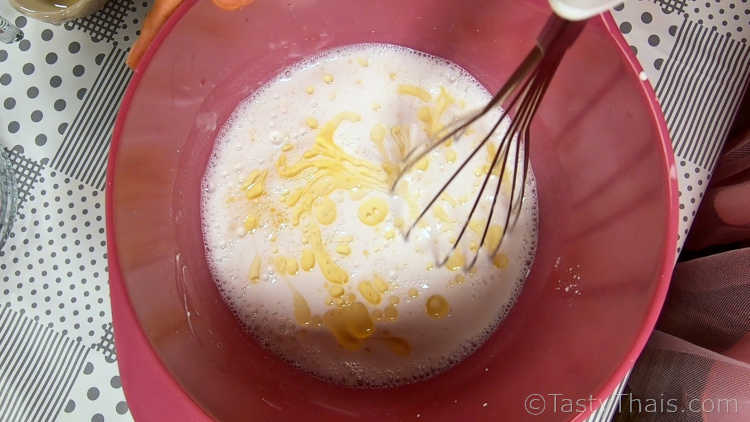
Step 2 – Allow the batter to Stand
The batter is left to stand for around an hour. You can get away with 30 minutes or let it stand a bit longer – even overnight but if longer than an hour, good food safety practice requires you to refrigerate to inhibit bacteria growth.
Standing the batter gives the water time to get together with the flour for a smoother batter.
As the flour particles will settle in standing water, give the mixture a whisk from time to time.
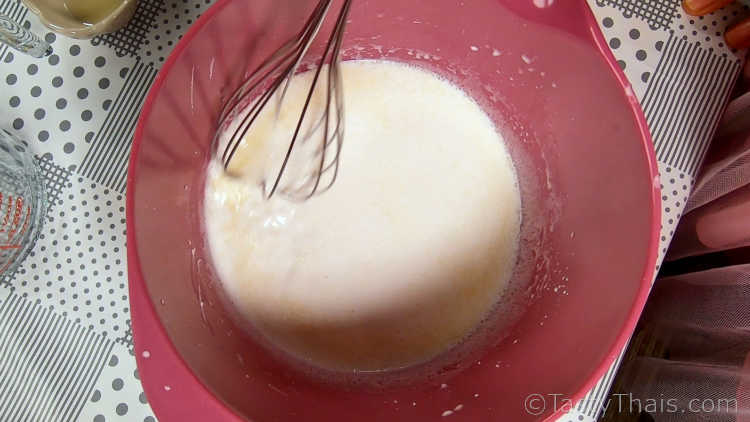
Step 3 – Prepare to Steam
Next, we need to get prepared for steaming the rice noodle sheets.
You’ll need a steamer and a pan with a very flat bottom (two pans even better), preferably shallow and that will fit into the steaming pot.
Add water to the steamer, get the water boiling, and then reduce heat to a simmer for gentle steam production.
Use an oil brush to coat the steaming pans with a thin layer of oil. Do not use too much – if you do then the oil will float up into the rice batter which we don’t want.
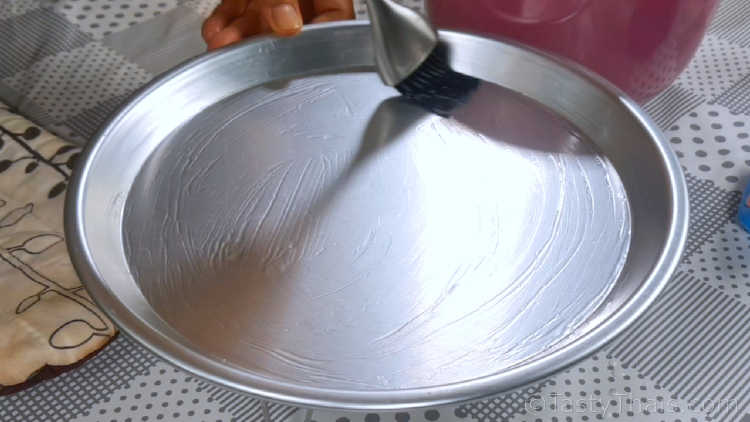
Lay out a towel so that you can take the steamer top pan and set it down while you swap plates – water will drip off so the towel helps keep us clean.
Oil up a surface to stack the noodle sheets before cutting – we use a cutting board which we can cut the noodles on after cooking up the batch. Use plenty of oil here as the noodles WILL stick otherwise and then break as you try to lift them.
Get yourself a nice flexible silicone spatula for easing the noodle sheets off the pan after cooking.
Step 4 – Steaming the Rice Noodle Sheets
Pour a little of the rice flour batter mix into the pan, enough to produce a thin but consistent layer over the whole pan. Don’t bother leveling it all yet, simply place the pan into the steaming pan and then place both onto the steamer.
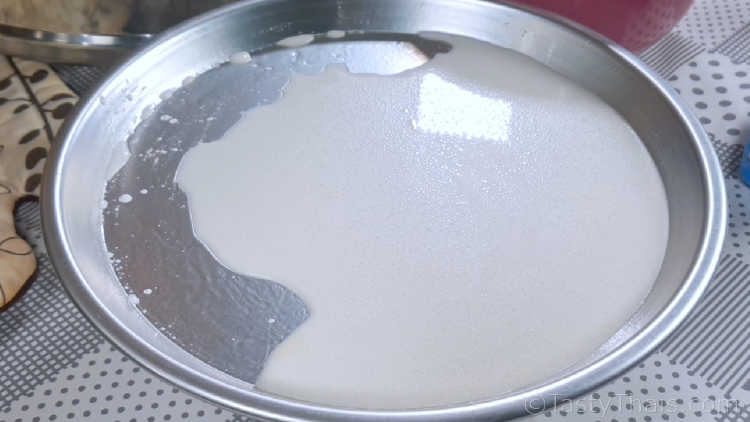
It is best putting the noodle-cooking pans into the steaming pan whilst it is off the steamer – you can put the lid back temporarily to keep the heat in. If you try to put the cooking pans in and out of the steamer when it is billowing steam then you will certainly burn yourself. Using the handles to lift off and separate the steaming pan will save your hurt!
With the steamer bottom section reunited with its steaming pan, set your kitchen timer for 5 minutes and then use the side handles to tilt the part holding the noodle-cooking pan so that the rice batter spreads out evenly. You will see it pull back from the oiled pan surface initially because of the surface tension of the batter – don’t worry.
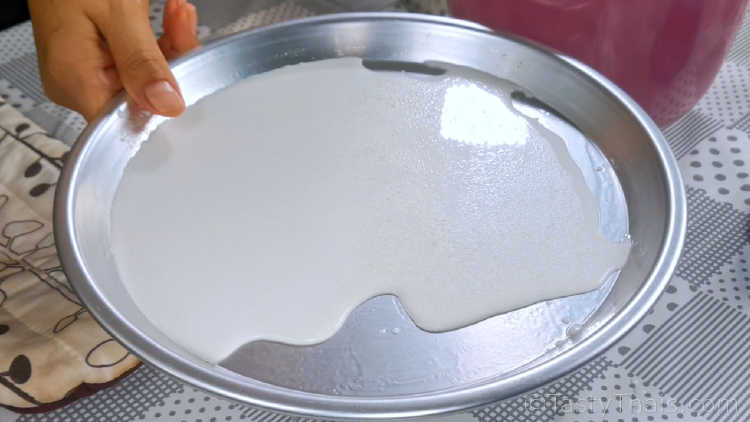
With the lid still off, wait about half a minute and try tilting the pan again to fill in any holes where the batter is not covering the bottom.
As the rice noodles begin to cook and set on the bottom you will be able to tilt the batter that is still runny on the top to cover all the holes – much as you would do if you were pan cooking thin UK style pancakes.
If you have been cooking for a minute or so and there is no batter left to tilt into place then simply use a long-handled ladle to pour in a little extra batter where it is not covering the pan bottom. The long-handled ladle helps to keep your hands out of the steamer and avoid burns).
When the batter is evenly covering the bottom of the noodle pan then put the steamer lid on and steam until the timer pings 5 minutes. Remember the timer is running from the time you put your pan into the steamer, not from when you have filled in all the holes!
If you steam shorter than 5 minutes then the noodle sheets will almost certainly be too fragile and break as you lift them out. If you cook longer than 5 minutes then the noodles will start to get tougher and chewier.
Your mileage and preference may vary but we suggest your first efforts use 5 minutes steam time and adjust from there as you get more practiced.
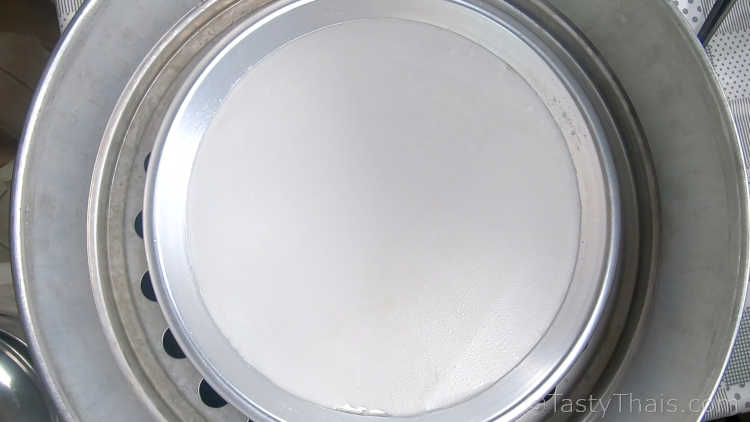
Step 5 – Stacking the noodles
With the steaming complete it is time to get the noodle sheets out of the steamer. Ready a second noodle pan in the second steamer pan tray if you have a double steamer – otherwise you will have to juggle with lids and trays a bit.
The idea is to get ready to whip out the cooked noodle sheet and replace it with the next one to cook while you are sorting out the cooked sheet. You will quickly settle into a rhythm from the process – you’ll end up like a motor production line!
Remove the steamer top section pan holding the noodle sheet cooking pan and steamer lid complete and place it on your towel. Lift the lid and replace it back on the steamer temporarily. Set your second noodle sheet cooking, set the timer, and so on following the same process as the first sheet.
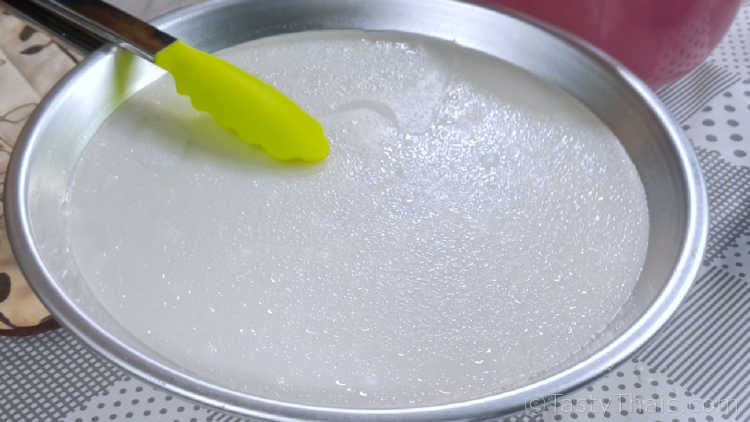
Using oven mitts or folded towels, lift the noodle sheet cooking pan out and allow to sit for a moment to cool a little and let the rice noodle sheets settle and cool which makes them easier to handle.
Brush the exposed top of the noodle sheet with plenty of oil because this surface will be the base for the next noodle sheet – and remember they are so lovely that they want to stick together – a lot!
With the top surface brushed with oil, take your flexible spatula and ease the noodle away from the edge all the way around the pan. When you are back to where you are started, push the spatula under further and the noodle sheet will peel up enough for you to grab with your fingers.
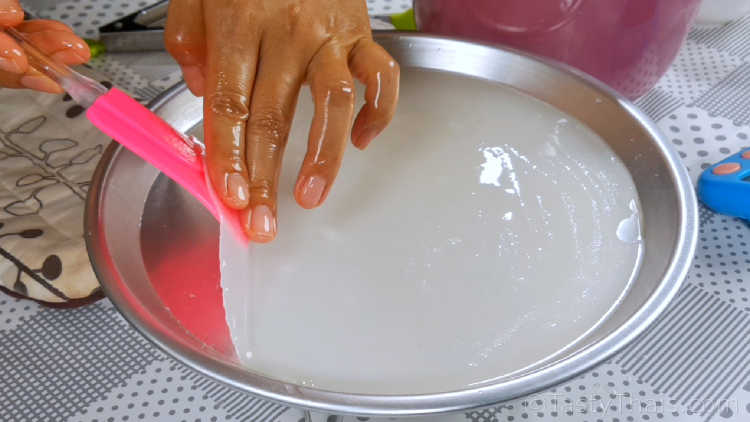
Using your fingers ease the noodle sheet upwards slowly sort of peeling away the sheet from the pan. When it is free lay it down with the surface that was touching the pan on the oiled resting surface.
Follow the process for the second noodle sheet, cooking the third, oiling the top of the second and peeling it off to place it on top of the previous one.
You’ll end up with a stack of noodle sheets. Two or three sheets are enough for a generous portion of noodles for a dish.
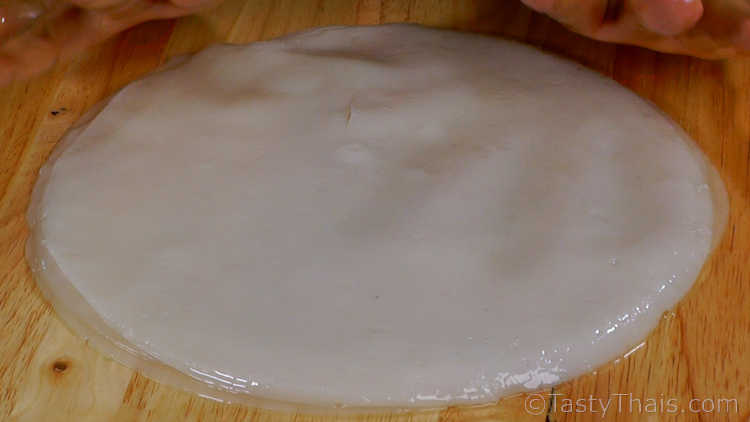
Step 6 – Cutting the Noodles and Storing
Once you have cooked up all your batter it is time to cut your noodles.
If you try to slice through these with a knife then the noodle will catch onto the knife and drag to make a ragged cut. If you have a wheeled pizza cutter then this is a simple way to cut neatly. Just brush around the cutter with oil to help it glide through.
If you must use a knife then be ready to keep oiling the sides above the blade to help reduce catching and raggedness.
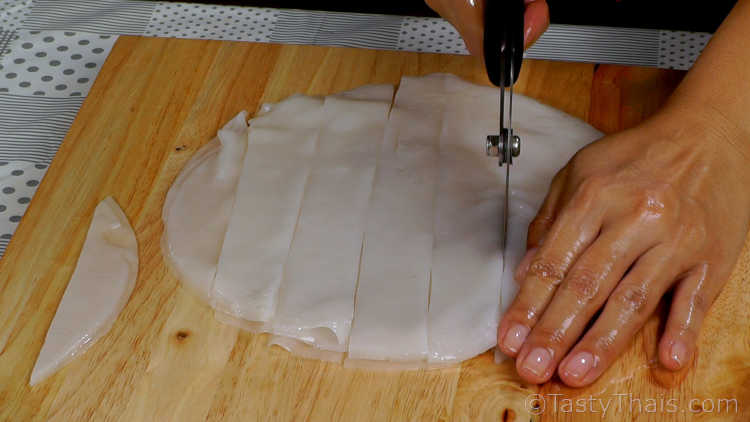
Cut the noodles into strips about 1 inch wide (about 25mm). You can cut several sheets at once but more than four or five stacked high the cutting becomes more difficult.
If you want to make Pad Thai Noodles then just cut the sheets about half as wide – 1/2 inch (12mm) instead of 1 inch!
Once your noodles are cut into strips then separate the strips with your fingers and loosely place on a plate ready for cooking.
Fresh rice noodles will not keep if left out so make a batch as you want to use them. If you have some leftover you can store at room temperature, well covered in oil and tightly wrapped in plastic wrap for use later the same day but any longer then you will need to store, wrapped, or covered in the refrigerator where they will last for several days.
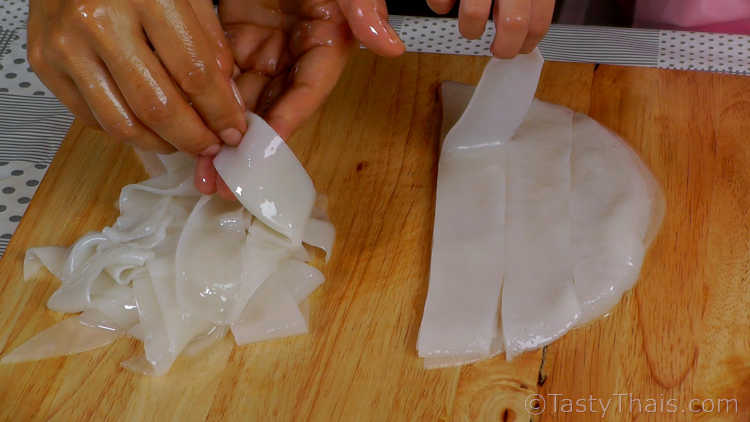
We never freeze these rice noodles because they are way tastier fresh and have a perfect consistency. Even when storing them in the fridge they are just not as good as ones freshly prepared. If you want to try freezing them you’ll find some useful information on freezing rice noodles here.
You should always store rice noodles uncooked rather than cooked in a dish. If you have leftover rice noodles that have already been incorporated in a dish then cover and refrigerate as soon as possible and cook within 24 hours -but remember stir-fries are best cooked fresh!

Homemade Wide Flat Rice Noodles (Sen Yai) Recipe
How to Make Homemade Wide Rice Noodles – Thai Sen Yai
The Video showing this recipe being cooked is near the top of the page – A convenient Jump Link to the video is below the description under here.
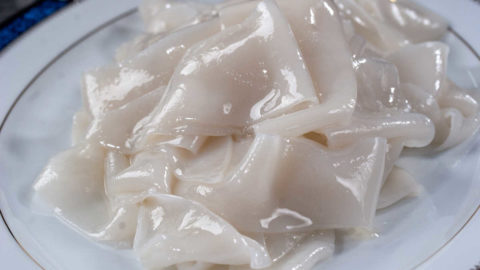
NOTE: Any In-recipe images can be toggled on and off with the camera icons next to the Instructions header.
Equipment
- Steamer
- Flat Pan
- Flexible Spatula
Ingredients
- 1 cup Rice Flour
- ½ cup Tapioca Flour
- 1½ cups Warm Water
- 1 tsp Salt
- 2 tbsp Olive Oil
- Vegetable Oil for separating noodle sheets
Instructions
Making the Rice Batter
- Add the rice flour, tapioca flour and salt to a mixing bowl and stir to mix consistently.

- Add the warm water whisking well to integrate the flour and water together. Once well mixed add in the olive oil and whisk thoroughly again.

- Allow the flour batter to stand for about an hour, occasionally giving it a quick whisk.

Steaming the Noodles
- Boil water in your steamer to get it ready.Use the vegetable oil to brush the pans thoroughly with a THIN covering of oil.Also brush plenty of oil on the surface you will use to place the cooked noodles on to cool and assemble for cutting.This is essential as the cooked noodles will readily stick together.

- Pour a thin layer of rice batter into the pan just enough to roughly cover. The batter will likely pull back from its surface tension exposing a little of the pan – dont worry.With the steaming tray in your steamer, place the pan into the steamer tray and allow to start cookign with the lid off. Use the handles of the steamer to tilt the steaming tray so that the liquid covers all the surface of the pan.As the noodle begins to cook it will thicken allowing you to direct the yet-to-be-cooked batter to fill any holes – much as you do with cooking thin pancakes.By about a minute to 90 seconds of steaming with the lid off you will know if you can cover the pan surface using the tilting method. If you can't get a full covering then sppon in a little more batter to fill the holes.Put the steamer lid on and cook for 4 more minutes fo a total of about 5 minutes (including the tilting / filling in time it was cooking). If you cook much longer than 5 minutes then the noodles will be easier to handle but more rubbery to eat as they toughen with overcooking.

- Once the 5 minutes is up, remove the noodle pan wearing heat resistant gloves. Lay the pan flat (use a protector if putting the hot pan on a delicate surface) and brush the exposed top of the noodle with a good covering of vegetable oil.Use a flexible silicone type spatula to ease away the side of the noodle all the way around and then slide under the edge of the noodle.Grab the exposed edge with your fingers and slowly pull it away until it comes free, placing it on the oiled cooling surface (we use a cutting board but anything flat will do).Meanwhile repeat the process with the next pan of noodle batter placing the cooked noodle on top of the last one in a stack. Once you get into a rhythm the process works like a charm and quite efficiently.

- Allow the noodles to cool a little before cutting. we find using a pizza cutting wheel most effective as flat knives have a greater tendency to drag.

Notes
Nutrition

Planning on Making this Recipe?
It would be great if you could take a picture of your finished creation and share it out on Instagram. Tag me with #TASTYTHAIEATS – I love to see your ideas!

I am a Thai mum and love cooking for my children. Over the years, I have taken my family recipes as well as ones borrowed from friends and adapted them to make them even tastier. I publish my authentic Thai Food Recipes here for all to enjoy around the world. When I get a chance to travel I publish information to help others visiting Thailand.
